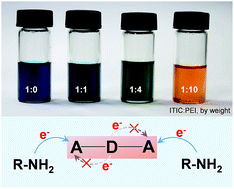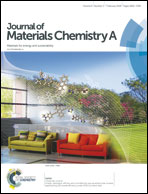Chemical reaction between an ITIC electron acceptor and an amine-containing interfacial layer in non-fullerene solar cells†
Abstract
The development of non-fullerene acceptors keeps pushing forward the efficiency record of organic solar cells and resulting in new solar cell physics and chemistry to research. ITIC-based materials are an important type of non-fullerene acceptors. Herein, we report a new finding that the ITIC acceptor can react with the widely used low work-function interfacial layer polyethylenimine (PEI or PEIE) in non-fullerene organic solar cells. The amine interfacial material reacts as a nucleophile with the C![[double bond, length as m-dash]](https://www.rsc.org/images/entities/char_e001.gif) O moiety of the ITIC, that destroys the original electronic structure and the intramolecular charge transfer of the ITIC molecules. Inverted non-fullerene solar cells with a PBDB-T:ITIC active layer deposited on PEI or PEIE display much lower PCE values compared with those of reference cells with the active layers deposited on ZnO electron-collecting interlayers. This chemical reaction between the ITIC acceptor and PEI or PEIE becomes more severe under thermal annealing and further deteriorates the solar cell performance. This original finding pays important attention to the design and development of the interfaces required for efficient non-fullerene organic solar cells.
O moiety of the ITIC, that destroys the original electronic structure and the intramolecular charge transfer of the ITIC molecules. Inverted non-fullerene solar cells with a PBDB-T:ITIC active layer deposited on PEI or PEIE display much lower PCE values compared with those of reference cells with the active layers deposited on ZnO electron-collecting interlayers. This chemical reaction between the ITIC acceptor and PEI or PEIE becomes more severe under thermal annealing and further deteriorates the solar cell performance. This original finding pays important attention to the design and development of the interfaces required for efficient non-fullerene organic solar cells.



 Please wait while we load your content...
Please wait while we load your content...